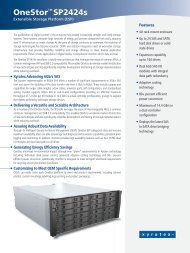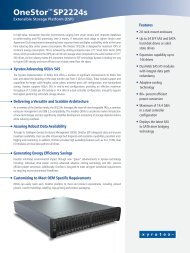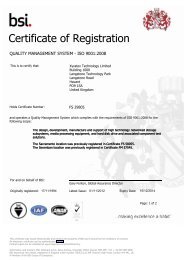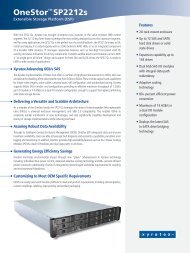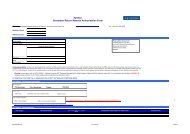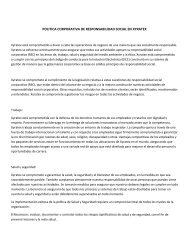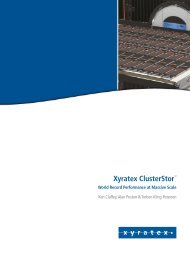RAID controller technology is projected to emerge and IDC have forecast a growth in adoption from60% in 2004 to approximately 98% in 2008. This is one of our strategic focuses and the prime driverbehind our acquisition of nStor RAID technology in September 2005.In less critical applications, the level of fault tolerance which RAID provides may not be requiredand storage needs can often be satisfied with JBOD storage systems. JBOD, which stands for ‘‘just abunch of disks,’’ is an externally attached storage system that integrates multiple disk drives. JBODsincorporate redundant system components, such as power and cooling, but lack the disk driveredundancy of RAID. While RAID and JBOD technologies are well accepted industry standards, theincreasing categorization of data, and resulting development of tailored storage system solutions, hasdriven a significant increase in the complexity of delivering RAID and JBOD technology acrossmultiple storage system product segments.We design, develop and manufacture storage subsystems that support a range of modular,high-speed communication technologies and performance specifications. Our modular design approachenables us to tailor our storage subsystems to meet the specific price and performance objectives of ourcustomers. As storage and networking protocols continue to proliferate, we believe the strategicimportance of our modular storage subsystems architecture will increase.Storage Infrastructure MarketThe projected increase in demand for data storage is expected to foster an increase in the volumeand density of disk drives manufactured to store this information. Based on a recent announcementfrom one of our major customers, we estimate that over the last twelve months, the industry shipped380 million disk drives totaling 35 million terabytes of storage, an increase of 60% from 2004. Aterabyte is a unit of measurement equal to 1,024 gigabytes of information. In addition, based on theannouncement we believe that during their quarter ended December 31, 2005, they shipped 3.5 milliondrives into Consumer Electronics (CE) applications, with 2.4 million of those units going into DigitalVideo Recorder (DVR) applications, an increase of 93% from the year ago quarter. The emergence ofnon-PC disk drive applications, such as gaming consoles, DVRs, MP3 players, cell phones and otherCE devices, is creating new disk drive markets and demand for products with a variety of physicalshapes or form factors. Trend Focus, in a report from April 2005, projects that the total volume of diskdrives shipped will double from 300 million shipped in 2004 to 600 million in 2009, representing acompound annual growth rate of 14.4%*. The main growth segment is in the consumer electronicssegment which is projected to grow to a third of the total market, at 215 million units, in 2009. Webelieve that 3.5 inch drives will remain a large portion of the CE market supporting predominantlyDVR and gaming applications. The 1.0 inch and 1.8 inch disk drives address a large range of mobiledevices including MP3 players, high end mobile phones, Personal Video Recorders (PVRs) and GPSdevices. 2.5 inch disk drives also have niches in many of the CE markets, in items such as slim linePVRs, gaming systems and some automotive applications.We believe that, in order to maintain and grow disk drive output, manufacturers will need toincreasingly invest in disk drive automation and process test equipment. The market for disk drive testequipment is largely driven by a combination of the growth in the areal density of disk drives (asmeasured by data bits per square inch), disk drive unit shipments, disk drive capacity and theemergence of new form factors and interface protocols.The emergence of high capacity SATA disk drives into enterprise storage systems is an example ofone of the factors driving an increase in the number of disks per drive which, for the enterprisesegment, is forecast by Trend Focus* to move from 2.02 in 2004 to 2.97 in 2007. In early 2003,* TrendFocus, dated April 2005.24
250 gigabytes disk drives were shipped into this segment to support new tape replacement applicationsfor disk drive technology. In early 2004, the available capacity per SATA drive had risen to 400gigabytes. Trend Focus believe that the growth in disk media volumes from 473 million in 2004 throughto over 741 million in 2007 will drive the need for further capital investments in disk processtechnology by both the disk drive companies and independent magnetic media suppliers. We believeour Storage Infrastructure strategy positions us well to take advantage of this new investment cycle inthe disk drive industry, particularly after the acquisition of magnetic disk media handling technology in2004 and our acquisition of precision cleaning process technology in 2005.Servo track writing and final disk drive testing are two standard steps that disk drive manufacturersperform in order to produce disk drives. Servo track writing is the process of laying down magneticpatterns on the surface of the disks. These patterns are used to define the location of circular tracks onwhich data is stored. The final test process stresses disk drives under extreme temperature and voltageenvironments and scans the surface of the disk to locate and isolate defects. These processes requireconsiderable production time and are costly for disk drive manufacturers. As the capacity of each diskdrive increases, as measured by areal density, so too does the number of tracks on each disk and henceproduction time. Using data supplied in a TrendFocus report from April 2005, we believe that theaverage gigabytes per drive was about 80 gigabytes in 2004 and is forecasted to grow to over 250gigabytes per drive in 2009. This represents a compound aggregate growth rate of 27%.The emergence in 2005 of perpendicular recording techniques within disk drives is a significantmarket dynamic and we estimate that it will be very difficult to achieve over 160 gigabyte per diskwithout it being actively deployed. Based on a report from one of our customers we believe that theaverage capacity per disk was 120 gigabytes in 2005, and forecast this amount to both double by 2007and also reach 480 gigabytes per disk by 2009. Perpendicular recording allows the magnetic circuit toflow perpendicularly through the layers of the disk rather than horizontally through the upper surfacelayers. This allows more magnetic material to be deployed per bit whilst simultaneously reducing thefootprint of each individual bit on the disc’s surface dramatically increasing the number of bits persquare inch. We believe that this increase in bits per inch also increases the sensitivity of the magneticmedia process to contamination as smaller defects are capable of affecting the magnetic performance ofthe disks. We believe this will result in increased investment cycles in precision cleaning equipment andautomated optical inspection techniques. We have seen significant additional capital investment inprecision cleaning process equipment in 2005.‘‘Over the next few years hard disk drive vendors will direct more resources towards reducingoperating expenditures through lower cost manufacturing, testing automation and standardizingprocesses,’’ according to John Buttress, IDC research manager for hard drives. ‘‘For example,automated testing equipment has enabled disk drive manufacturers to improve the overall efficiency offinal test processes, generating cost and cash flow benefits and time-to-market advantages.’’We believe that as the number of interfaces and disk drive options continue to proliferate into amultitude of end-user applications, disk drive manufacturers will increasingly seek partners to provideprocess automation solutions to deliver cost efficiencies, time-to-market advantages and enable theprioritization of internal resources in order to achieve strategic objectives.We design, develop and manufacture process automation solutions that enable customers to testand produce highly reliable disk drives and magnetic disk media with greater efficiency and at a lowercost. In addition, our next-generation test systems allow our customers to load, test and unload eachdrive individually and asynchronously. Our asynchronous testing systems reduce the time required forprocessing disk drives, allowing for a more efficient use of capital equipment. Our test systems areintegrated into our customers’ manufacturing floor control systems and can be remotely monitoredthroughout the testing process. We have established long-term relationships with leading disk drivemanufacturers, including Seagate Technology and Western Digital.25
- Page 3: XYRATEX LTDANNUAL REPORT FOR THE YE
- Page 6 and 7: INTRODUCTIONWe are incorporated und
- Page 8 and 9: Year Ended November 30,2005 2004 20
- Page 10 and 11: The computations for the weighted a
- Page 12 and 13: The markets in which we operate are
- Page 14 and 15: technological capabilities. This co
- Page 16 and 17: may cease production of components,
- Page 18 and 19: • potentially adverse tax consequ
- Page 20 and 21: We could incur substantial costs, i
- Page 22 and 23: influence by voting at a meeting of
- Page 24 and 25: Xyratex Ltd to the former sharehold
- Page 26 and 27: In addition to the rapid growth of
- Page 30 and 31: Our Competitive StrengthsDisk drive
- Page 32 and 33: the storage subsystem and disk driv
- Page 34 and 35: Our storage subsystems are internal
- Page 36 and 37: systems are capable of testing a fu
- Page 38 and 39: Research and DevelopmentWe have ove
- Page 40 and 41: • sets forth procedures for the p
- Page 42 and 43: Item 4C: Organization StructureXyra
- Page 44 and 45: ecame the parent company of our bus
- Page 46 and 47: Foreign Exchange Rate FluctuationsT
- Page 48 and 49: we recorded in the year ended Novem
- Page 50 and 51: Fiscal Year Ended November 30, 2005
- Page 52 and 53: Research and Development—otherThe
- Page 54 and 55: Fiscal Year Ended November 30, 2004
- Page 56 and 57: Selling, General and Administrative
- Page 58 and 59: Quarterly Results of OperationsThe
- Page 60 and 61: sales growth. The increase in defer
- Page 62 and 63: choose to make or alliances we have
- Page 64 and 65: compete. Identifiable intangible as
- Page 66 and 67: ITEM 6: DIRECTORS, SENIOR MANAGEMEN
- Page 68 and 69: Ernest Sampias has served as a dire
- Page 70 and 71: Audit CommitteeOur Audit Committee
- Page 72 and 73: Employee Benefit/Share Option Plans
- Page 74 and 75: The maximum amount that any partici
- Page 76 and 77: Restricted StockRestricted stock aw
- Page 78 and 79:
the options, warrants or rights, bu
- Page 80 and 81:
Quarterly high and low market price
- Page 82 and 83:
whose functional currency is not th
- Page 84 and 85:
on the Nasdaq National Market and,
- Page 86 and 87:
Interest RatesWe had cash and cash
- Page 88 and 89:
aggregate in any fiscal year and th
- Page 90 and 91:
(This page has been left blank inte
- Page 92 and 93:
XYRATEX LTDAUDITED CONSOLIDATED BAL
- Page 94 and 95:
F-4XYRATEX LTDAUDITED CONSOLIDATED
- Page 96 and 97:
XYRATEX LTDNOTES TO AUDITED CONSOLI
- Page 98 and 99:
XYRATEX LTDNOTES TO AUDITED CONSOLI
- Page 100 and 101:
XYRATEX LTDNOTES TO AUDITED CONSOLI
- Page 102 and 103:
XYRATEX LTDNOTES TO AUDITED CONSOLI
- Page 104 and 105:
XYRATEX LTDNOTES TO AUDITED CONSOLI
- Page 106 and 107:
XYRATEX LTDNOTES TO AUDITED CONSOLI
- Page 108 and 109:
XYRATEX LTDNOTES TO AUDITED CONSOLI
- Page 110 and 111:
XYRATEX LTDNOTES TO AUDITED CONSOLI
- Page 112 and 113:
XYRATEX LTDNOTES TO AUDITED CONSOLI
- Page 114 and 115:
XYRATEX LTDNOTES TO AUDITED CONSOLI
- Page 116 and 117:
XYRATEX LTDNOTES TO AUDITED CONSOLI
- Page 118 and 119:
XYRATEX LTDNOTES TO AUDITED CONSOLI
- Page 120 and 121:
XYRATEX LTDNOTES TO AUDITED CONSOLI
- Page 122 and 123:
XYRATEX LTDNOTES TO AUDITED CONSOLI
- Page 124 and 125:
XYRATEX LTDNOTES TO AUDITED CONSOLI
- Page 126 and 127:
XYRATEX LTDNOTES TO AUDITED CONSOLI
- Page 128 and 129:
XYRATEX LTDNOTES TO AUDITED CONSOLI
- Page 130:
(This page has been left blank inte



